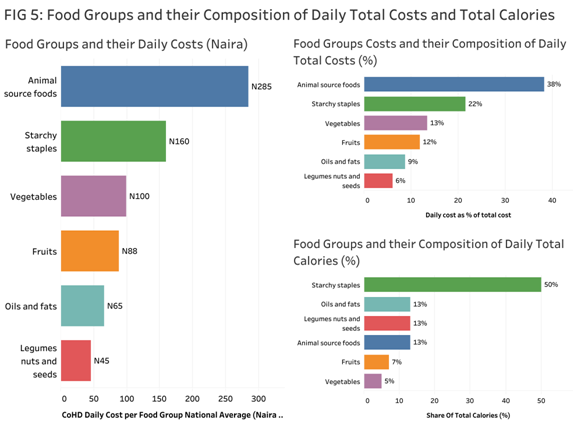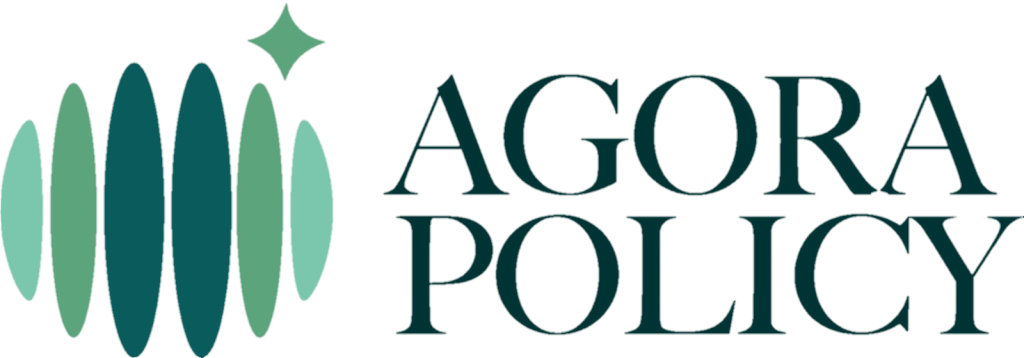By Babajide Fowowe | Last week, the National Bureau of Statistics (NBS) released the first of a series of new reports, titled the Cost of a Healthy Diet (CoHD). The NBS defines the cost of a healthy diet as “the cost per day of the least expensive combination of foods that meets the daily requirements for a healthy diet for an adult”1. Thus, the CoHD represents the minimum daily requirements for an adult to obtain a healthy meal. The healthy diet basket consists of 11 food items: three items of vegetables, two items of starchy staples, two items of fruits, two items of animal source foods, one item of oils and fats, and one item of legumes, nuts and seeds2.
As would be expected in a diverse country such as ours, there are disparities in the cost of a healthy diet across rural and urban areas, states, geo-political zones, and over time. For example, in December 2023, the daily cost of a healthy diet was lowest in Katsina State with N594; while it was highest in Ekiti State with N1,052. This means that in order to maintain a healthy diet, the average adult in Ekiti State would have to spend almost double what the average adult in Katsina State would spend.
The availability of regular and consistent data on the cost of a healthy diet is very useful for a number of reasons. First, a healthy diet is critical for maintaining good health, which is a precursor to better standards of living. Second, knowledge about how costly a healthy diet is will be helpful in shaping policies around ensuring affordability of food. Third, the CoHD can help to track prices and highlight areas, states or zones where essential food prices are high, and inform efforts to tackle such high prices.
In what follows, we present six key insights from the CoHD reports recently released by NBS.
Insight 1: The National Average of the Cost of a Healthy Diet Increased by 68.3% between January 2023 and December 2023
The national average of the CoHD increased from N467 in January 2023 to N786 in December 20233 (Figure 1). This implies an increase of 68.3%. The average CoHD was below N500 from January till April, but increased to N503 in May. It increased to N515 in June and these increases continued until December. The steepest increase occurred between June and July when the COHD increased from N515 to N590 (14.6%), while the lowest increase occurred in March, with CoHD increasing from N478 to N480 (0.42%).
It is particularly insightful that the CoHD increased for each successive month throughout the year. One would have expected food prices to change with the seasons. In particular, it would have been expected that prices would be lower during the rainy season. However, costs increased by larger percentages during the rainy season. This suggests that some extraneous factors are affecting food prices. The second half of the year had the largest increases, perhaps reflecting the effects of the removal of petroleum subsidies and foreign exchange reforms.

Source: National Bureau of Statistics (NBS): The Cost of a Healthy Diet (CoHD)
Insight 2: The Cost of a Healthy Diet is Lower in Northern Nigeria than Southern Nigeria
Between October and December 2023, the average cost of a healthy diet was lowest in the North East at N633, followed by N644 in the North West, and N665 in the North Central Figure 2). For the same period, the average CoHD was highest in the South East at N919, followed by the South West at N872, and South South at N788. Thus, it costs more to buy a healthy food that constitutes a healthy diet in the southern part of the country than in the northern part.

Source: National Bureau of Statistics (NBS): The Cost of a Healthy Diet (CoHD)
Examination of the data for individual states reveals the same picture. All the northern states had CoHD below the national average, while Cross River was the only southern state with CoHD below the national average (Figure 3). Thus, interestingly, the national average seems to act like a dividing line between the northern and southern parts of the country. This is not particularly surprising, as the northern part of the country has historically produced more food than the south.

Source: National Bureau of Statistics (NBS): The Cost of a Healthy Diet (CoHD)
Insight 3: The Cost of a Healthy Diet is Lower in Rural Areas than Urban Areas
Between October and December 2023, the cost of a healthy diet was cheaper in rural areas than urban areas in 32 states (including the FCT), while CoHD was cheaper in the urban areas than rural areas in five states (Kebbi, Katsina, Kwara, Taraba, and Kaduna). There is wide disparity in the magnitude of these differences (Figure 4). The CoHD in the urban areas was higher than the rural areas by more than N100 in four states (Adamawa, Gombe, FCT, Bauchi). The difference was between N50 and N99 in six states (Nasarawa, Rivers, Imo, Niger, Anambra, Plateau). For the remaining states, the difference was lower than N50.

Source: National Bureau of Statistics (NBS): The Cost of a Healthy Diet (CoHD)
Insight 4: Animal Source Foods Account for the Largest Share (38%) of the Cost of a Healthy Diet while Legumes, Nuts and Seeds Account for the Lowest Share (6%)
Between October and December 2023, the average cost of animal source foods in the healthy diet was N285 (Figure 5). This represents 38% of the total average CoHD of N744 for these months (Figure 5). Starchy staples had the second highest daily cost of N160 (22%), followed by vegetables with a daily cost of N100 (13%). Fruits had a daily average cost of N88 (12), oils and fats cost N65 (9%), and legumes, nuts and seeds on average cost N45 (6%).
For the share of total calories, starchy staples accounted for the highest share (50%) (Figure 5). This is followed by oils and fats (13%), animal source foods (13%), and legumes nuts and seeds (13%), fruits (7%) and vegetables (5%). It is interesting that while animal source foods make up only 13% of the total daily calories, they account for the largest share (38%) of total daily CoHD.

Source: National Bureau of Statistics (NBS): The Cost of a Healthy Diet (CoHD)
Insight 5: The Cost of a Healthy Diet for Children is Missing
Interestingly, the cost of a healthy diet for children is omitted from the report. Considering the fact that the Multidimensional Poverty Indicators for 2022 showed that there are more poor children than poor adults, it is important to know the CoHD for children. Severe undernutrition is a serious issue, with 30.5% of children under 5 living in a household in which at least one child under5 is severely stunted or severely underweight4. 36.8% of children under 5 suffer from malnutrition as evidenced by stunting5. These figures show the severity of child malnutrition in the country. It is thus essential to understand how much it would cost for children to get the minimum daily requirements for a healthy diet.
Insight 6: For Many States, Workers on the Minimum Wage will Struggle to Fund Other Expenditure after Buying Food
The NBS noted that the figures provided for CoHD represent the minimum cost, and do not include transportation and preparation costs. When transportation and preparation costs are included, the CoHD will rise. This brings into stark reality the high costs of healthy diets, especially for low income earners. Using the December 2023 figures, the average national daily cost of a healthy diet was N786. Simply multiplying this by the 31 days in the month gives a value of N24,369. There is wide disparity when this monthly total is computed for all states (Figure 6). States like Ekiti, Osun, Ondo, Lagos and Ogun have monthly total monthly costs above the minimum wage of N30,000 (Figure 6). Nine states had monthly totals below N21,000: Katsina, Niger, Adamawa, Borno, Zamfara, Kaduna, Benue, Jigawa, and Kano. These monthly total figures will increase when transportation and preparation costs are added. For workers on the minimum wage of N30,000 per month residing in states with monthly totals above the national average of N24,369, after buying food, there will be very little left to feed and care for children, and fund other critical expenditure.

Source: National Bureau of Statistics (NBS): The Cost of a Healthy Diet (CoHD)
Conclusion
This short note has presented six key insights from the new Cost of a Healthy Diet reports released by the NBS. We note that these reports are important, because the availability of regular and consistent data on the cost of a healthy diet is very useful for policy. It is hoped that the NBS will continue to release these reports to further provide information, strengthen dialogue and engagement, and ultimately lead to better food policies in the country.
Footnotes
1. https://nigerianstat.gov.ng/elibrary/read/1241452
2. Ibid.
3. The data for the whole year was only available for the national average, but disaggregated data for states was not available for the whole year
4. https://nigerianstat.gov.ng/elibrary/read/1241254
5. https://hdr.undp.org/content/human-development-report-2021-22



